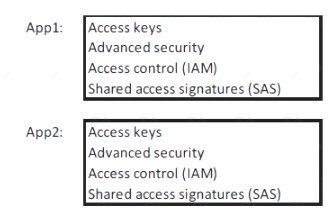- (Exam Topic 5)
You have an Azure subscription named Subscription1 that contains the virtual networks in the following table.
Subscripton1 contains the virtual machines in the following table.
In Subscription1, you create a load balancer that has the following configurations:  Name: LB1
Name: LB1 SKU: Basic
SKU: Basic  Type: Internal
Type: Internal Subnet: Subnet12
Subnet: Subnet12 Virtual network: VNET1
Virtual network: VNET1
For each of the following statements, select Yes if the statement is true. Otherwise, select No.
NOTE: each correct selection is worth one point.
Solution:
Statement 1 : Basic load balancer supports Virtual machine in a single Availability set or virtual machine scale set (VMSS) only . Hence this statement is correct.
Statement 2 : Basic load balancer supports Virtual machine in a single Availability set or virtual scale set only or one standalone VM. VM3 and VM4 are not part of any availability set or VMSS .Hence this statement is incorrect.
Statement 3 : Basic load balancer supports Virtual machine in a single Availability set or virtual scale set on or one standalone VM. VM5 and VM6 are not part of any availability set or VMSS .Hence this statement is incorrect.
References:
https://docs.microsoft.com/en-us/azure/load-balancer/load-balancer-overview
Does this meet the goal?
Correct Answer:A
- (Exam Topic 6)
Note: This question is part of a series of questions that present the same scenario. Each question in the series contains a unique solution that might meet the stated goals. Some question sets might have more than one correct solution, while others might not have a correct solution.
After you answer a question in this section, you will NOT be able to return to it. As a result, these questions will not appear in the review screen.
You manage a virtual network named VNet1 that is hosted in the West US Azure region. VNet1 hosts two virtual machines named VM1 and VM2 that run Windows Server.
You need to inspect all the network traffic from VM1 to VM2 for a period of three hours. Solution: From Azure Network Watcher, you create a packet capture.
Does this meet the goal?
Correct Answer:A
https://azure.microsoft.com/en-us/updates/general-availability-azure-network-watcher-connection-monitor-inall
- (Exam Topic 6)
You have an Azure Active Directory (Azure AD) tenant named contoso.onmicrosoft.com.
You hire a temporary vendor. The vendor uses a Microsoft account that has a sign-in of user1@outlook.com. You need to ensure that the vendor can authenticate to the tenant by using user1@outlook.com.
What should you do?
Correct Answer:D
UserPrincipalName - contains the UserPrincipalName (UPN) of this user. The UPN is what the user will use when they sign in into Azure AD. The common structure is @, so for Abby Brown in Contoso.com, the UPN would be AbbyB@contoso.com
Example:
To create the user, call the New-AzureADUser cmdlet with the parameter values:
powershell New-AzureADUser -AccountEnabled $True -DisplayName "Abby Brown"
-PasswordProfile$PasswordProfile -MailNickName "AbbyB" -UserPrincipalName "AbbyB@contoso.com"
References:
https://docs.microsoft.com/bs-cyrl-ba/powershell/azure/active-directory/new-user-sample?view=azureadps-2.0
- (Exam Topic 6)
You have an Azure Active Directory (Azure AD) tenant that syncs to on-premises Active Directory and
contains the users shown in the following table.
You create a group named Group1 and add User1 to the group. You need to configure the ownership of Group 1. Which users can you add as owners of Group1?
Correct Answer:C
Before creating a network interface, you must have an existing virtual network in the same location and subscription you create a network interface in.
Reference:
https://docs.microsoft.com/en-us/azure/virtual-network/virtual-network-network-interface
- (Exam Topic 6)
You have an Azure Storage account named storage1.
You have an Azure App Service app named app1 and an app named App2 that runs in an Azure container instance. Each app uses a managed identity.
You need to ensure that App1 and App2 can read blobs from storage1 for the next 30 days. What should you configure in storage1 for each app?
Solution:
With Shared access signature you can limit the resources for access and at the same time can control the duration of the access.
A shared access signature (SAS) provides secure delegated access to resources in your storage account without compromising the security of your data. With a SAS, you have granular control over how a client can access your data. You can control what resources the client may access, what permissions they have on those resources, and how long the SAS is valid, among other parameters.
Reference:
https://docs.microsoft.com/en-us/azure/storage/common/storage-sas-overview
Does this meet the goal?
Correct Answer:A